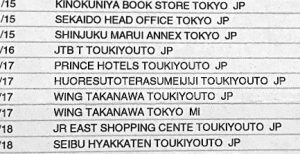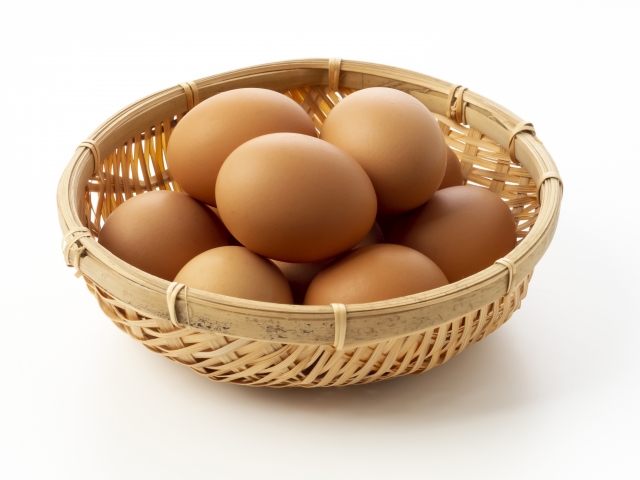[print-me]
和文は英文の下に続きます。/ The Japanese translation is on the bottom of this page.

両面相(りょうめんそう)のポスター
Long Vowels
Contents
- A word containing long vowels
- How they Romanize Japanese long vowels
- Our policy and the reasons
- How to pronounce basic short vowels
- How to pronounce long vowels
- A note for English speakers
- An episode with long vowels
- The irregularities in spelling
- All of us can improve on pronunciation
************************************
1. A word containing long vowels
We found an interesting poster at JR Shinagawa Station in Tokyo (See Photo 1), a traditional double-faced image. It was an advertisement for a “rakugo” or a traditional, one-man comedy theater, popular at the beginning of the year (in January).
Turn the picture upside down. Can you see a smiley face, as opposed to his frown you see now? The face can be seen from both sides, so it’s called “ryoomensoo (“ryoo” means both, “mensoo” means face)”.
2. How Japanese long vowels are Romanized
For those who have not learned hiragana yet, and for those who have wondered at different ways to spell “Tokyo” (Toukyou, Toukiyou, Tokyo, etc) in the alphabet, we would like to discuss the long vowels in this post.
Actually, there is no established Romanization of the Japanese long vowels.

For example, “ryoomensoo” (double-faced image) is spelled in different ways; ryomenso, ryoumensou, ryoomensoo, ryomenso with a short horizontal line on top of each “o” to show it’s a long vowel etc.
In this site, we will adopt the way to spell “roomensoo” and “Tookyoo”. For now we think it’s the simplest.
The following is our reasoning.
3. Our policy on the spelling of long vowels
Our spelling policy has two big strong points.
(1) It’s one rule and there is no exception.
(2) Without the knowledge of hiragana or katakana, you will be able to pronounce Japanese in our posts easily and correctly.
4. How to pronounce basic short vowels
See below for various shapes of the mouth. Here is how to read the basic, short vowels of the Romanized Japanese.

The top left photo is to pronounce “a”, top right “i”, in the second row on the left “u”, second right “e”, and bottom left “o”. In saying the vowels, just shape your mouth like them and make a sound by letting air out naturally.
For your information, the bottom right is “n”.
5. How to pronounce long vowels
As for the long vowels, we will simply write “aa”, “ii”, “uu”, “ee”, “oo”. In pronouncing them, just prolong the short vowel without changing the shape of your mouth. In other words, for example, you pronounce “aa” as if you were saying two short “a” sounds put together without a break.
Example 1: Okaasan, おかあさん or mother
6. A note for English speakers
If your mother tongue is English, please pay particular attention to “ee” and “oo” because we hardly hear these sounds in English. Say it as two short “e” sounds put together without a seam, and two “o” sounds likewise, respectively.
Ex. 2: Sensee, せんせい or teacher
Ex. 3: Daijoobu, だいじょうぶ or “I’m OK”
7. The spelling of long vowels in hiragana
In many books, you see Ex. 2 and Ex. 3 written as “sensei” and “daijoubu” respectively. It’s because people feel like writing “ei” and “ou” instead of “ee” and “oo” due to some special spelling rules with hiragana. The rule is: Prolonged “e” and “o” sounds are spelled with い (“i”) and う (“u”) respectively.
When we were small, we learned the rule this way: In our first grade class, we learned hiragana. Then we were encouraged to write words we knew. When we wrote せんせえ (se-n-se-e, teacher), because that’s how it sounds, our teacher corrected it. It had to be written せんせい (se-n-se-i) because there is a special rule. A long “e” sound must be spelled with “i”.
The same thing happened to “oo”. We wrote だいじょおぶ (da-i-jo-o-bu, ”It’s OK!”) as we pronounced, and she corrected it to だいじょうぶ because that’s the rule.
Later we learned such exceptions as こおり (ko-o-ri, ice), とおい (to-o-i, far), おおきい (o-o-ki-i, large), ほお (ho-o, cheeks of a face) and so on.
Why are there two ways to spell the long “o” and “e” vowels? We should think various changes have occurred to Japanese sounds over the centuries, and these are one of the results arising from them.
8. The irregularities in spelling long vowels
There have been a couple of systems, the so-called the official Romanization method and the Hepburn method, to transcribe Japanese sounds into the Alphabet since the Meiji Era. More recently, a word processing system was developed using the English typewriting keyboard and has become also popular. Which of the systems is the best is yet to be decided.
Our way is none of the above, but the simplest and most true-to-the-sound, as in “Tookyoo”. Wouldn’t it be wonderful if people could learn how to speak Japanese without having to learn hundreds of Japanese and Chinese characters, and travel to Japan and speak with the locals right away? So we hope some easy Romanization system like this will be prevalent one day.
Of course we would like you to learn Japanese like we did in the traditional way. But we also know there are not many people who have time and energy to do it and to have the exposure to the Japanese language to keep everything in memory.
9. All of us may have room for improvement on Pronunciation
Interestingly, Photo 2 intends to improve the pronunciation of native Japanese speakers. We wondered why.
In Japan, we receive no public speaking training at school. This may be one of the reasons, but we often speak Japanese in a mumble and sound inarticulate. So this can be advice for that situation.
At the same time, we do not always speak in a complete sentence. It’s not wrong to speak like this; it’s just a character of the language. In Japanese, we do not mention what’s already understood from the context, so we give information, ask a question, and answer, in a choppy way.
In addition, as we discussed on the Japanese nasal sound in =>“The Mini Pocket” [Link is coming soon], there is a wide variety in the pronunciation and accent in different regions in Japan.
Your Japanese teachers, on the other hand, may be speaking to you more slowly and articulately than otherwise. So it’s not your fault if you don’t hear easily when you are in Japan.
Related Posts
=>Return to Recent Posts/「新着記事」へ戻る
=>Return to Home/「ホーム」へ戻る
[End of English text]
長音
目 次
- 長音を含む言葉
- 長音をローマ字でどう書くか
- このサイトの長音のローマ字書き
- 基本の短母音の読み方
- 長音の読み方
- 英語話者へのメモ
- ひらがなの長音の書き方
- ローマ字表記の不統一
- 私たち皆の日本語の発音に向上の余地が
1. 長音を含む言葉
JR品川駅で、面白いポスターを見つけました。昔ながらの両面相です (写真 1)。寄席の演芸会の広告でした。1月によくある催しです。
ポスターの絵を逆さまにしてください。こちら側はしかめ面だったけれど、笑顔が見えますか。どちらからも顔が見えるので、両面相というのです。
2. 長音をローマ字でどう書くか
この投稿では、ひらがなを習っていない方、なぜ東京にToukyou、Toukiyou、Tokyoなど異なるローマ字表記があるのかなと思っていた方のために、長音のお話をしたいと思います。
実は、ローマ字による日本語の長音の表記は統一されていません。
例えば、この「りょうめんそう」も、いろいろな書き方があります。Ryomenso、ryoumensou、ryoomensoo、二つの o の上にそれぞれ短い線を引いた ryomenso などなど。
このサイトでは、ryoomensoo、Tookyooなどと表記するやり方を採用します。今のところ、ローマ字表記の一番簡単なルールだと思うからです。
その理由は以下の通りです。
3. このサイトの長音のローマ字書き
これには、ふたつ長所があります。
(1)ルールがひとつしかなく、例外がないこと
(2)ひらがな、かたかなを知らなくても、簡単に正しく発音できること
4. 基本の短母音の読み方
口の形を示す写真2を見てください。これが、基本的な短母音を読むときの口の形です。
左上の写真は「あ」の発音、右上は「い」、二番目の左は「う」、二番目右は「え」、左下は「お」です。写真のような口の形で自然に息を出すと、それぞれの母音を発音することができます。
なお、右下は「ん」です。
5. 長音の読み方
長音については、そのまま aa、ii、uu、ee、oo と書きます。読み方は、短母音を口の形を変えずに延ばすのです。つまり、例えば、aa は、a の音をふたつ、途切らせず発音します。
例1: おかあさん
6.英語話者へのメモ
英語を母語とする方は、ee と oo には気を付けてください。この二つは英語ではほとんど聞かれません。これらは、それぞれ e と o をふたつ切れ目なしに言うのです。
例2: sensee せんせい
例3: daijoobu だいじょうぶ
7.ひらがなの長音の書き方
多くの本では、sensei や daijoubu など、ee の代わりに ei、oo の代わりに ou を使います。なぜこのような違いが生じるかというと、ひらがなの表記における規則のためです。その規則とは、e と oの長音はそれぞれ「い」「う」と書く、というものです。
その規則を、私たちはこんな風に習いました。一年生でひらがなを習った時、知っている言葉を書くよう言われたのですが、発音どおりに「せんせえ」と書いて、先生に直されたのです。長い「え」は「い」と書くもので、「せんせい」と書かないといけない、と。
o の長音も同じことでした。発音通りに「だいじょおぶ」と書いて、先生に直されました。「だいじょうぶ」と書かなければいけないのです。
のちに、「こおり」「とおい」「おおきい」「ほお」などの例外を習いました。
なぜ「え」と「お」の長音に二つの表記法があるのでしょうか?日本語の音は数世紀の間にさまざまな変化を経てきましたが、これらはその結果起きたことのひとつだと考えていただくといいと思います。
8. ローマ字表記の不統一
明治時代から、日本語をアルファベットに書き換えるやり方は二つありました。それから、もっと新しく、英語のタイプライターキーボードを使って日本語を入力するシステムが開発され、広まりました。このうちどのシステムが最善かについて、定説はありません。
私たちの方法は上のどれでもありませんが、Tookyooのように、一番単純で音を正しく表します。日本語会話を習うとき、かなや漢字を何百も覚える必要がなく、日本へ旅行してすぐ地元の日本人と話せる、そういうことになったら素晴らしいですよね。そのため、こんな簡単なローマ字表記法があればいいなと思うのです。
もちろん本当は、従来のやり方で、皆さんに私たちと同じように日本語を習って欲しいです。でも、それをする時間とエネルギーがあって、しかも忘れないようにいつも日本語に触れていられる人は、多くはないともわかっています。
9. 私たち皆の日本語の発音に向上の余地が
おもしろいことに、写真2は、日本語を母語とする人の発音向上を目的としたものです。なぜか、考えてみました。
日本では学校で公の場で話す練習をしないこともあり、私たちも含めて、もぐもぐ話したり、はっきり発音しなかったりすることがよくあります。そういうことへのアドバイスかもしれません。
また、私たちはいつも完全文で話すわけではありません。日本語では、文脈からわかることは言わないので、情報を与えたり、質問したり、答えたりするのに、断片的な言い方をよくします。これは、日本語の特徴でもあり、別に間違ったことではないのですが。
さらに、以前、鼻濁音について=>「ミニ・ポケットの話」でお話ししたように、日本各地に数多く発音のバリエーションがあります。
一方、日本語教師は、どちらかといえばゆっくりめ、はっきりめに話します。ですから、日本に行ったとき聞き取りが難しくても、あなたの勉強の仕方のせいではありません。
[和文部終わり]
関連リンク
英文部末尾をご参照ください。
=>Return to 2019 Posts / 2019年投稿記事へ戻る
=>Return to Home/「ホーム」へ戻る


